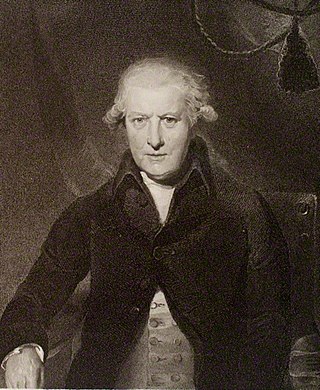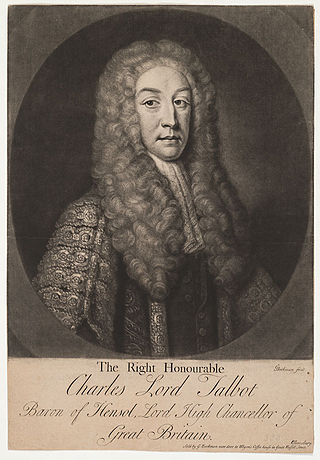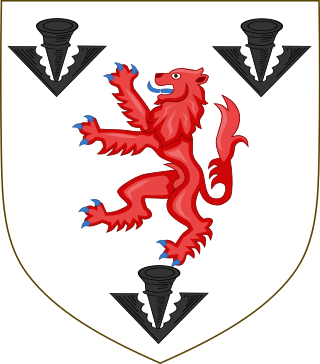
Viscount Barrington, of Ardglass in the County of Down, was a title in the Peerage of Ireland. It was created in 1720 for the lawyer, theologian and politician John Barrington. He was made Baron Barrington, of Newcastle in the County of Limerick, also in the Peerage of Ireland, at the same time.

Duke of Atholl, named after Atholl in Scotland, is a title in the Peerage of Scotland held by the head of Clan Murray. It was created by Queen Anne in 1703 for John Murray, 2nd Marquess of Atholl, with a special remainder to the heir male of his father, the 1st Marquess.

Earl of Shrewsbury is a hereditary title of nobility created twice in the Peerage of England. The second earldom dates to 1442. The holder of the Earldom of Shrewsbury also holds the title of Earl of Waterford (1446) in the Peerage of Ireland and Earl Talbot (1784) in the Peerage of Great Britain. Shrewsbury and Waterford are the oldest earldoms in their peerages held by someone with no higher title, and as such the Earl of Shrewsbury is sometimes described as the premier earl of England and Ireland.

Earl of Coventry is a title that has been created twice in the Peerage of England. The first creation for the Villiers family was created in 1623 and took its name from the city of Coventry. It became extinct in 1687. A decade later, the second creation was for the Coventry family and is still extant.

Baron Stafford, referring to the town of Stafford, is a title that has been created several times in the Peerage of England. In the 14th century, the barons of the first creation were made earls. Those of the fifth creation, in the 17th century, became first viscounts and then earls. Since 1913, the title has been held by the Fitzherbert family.

Earl Talbot is a title that has been created twice in the Peerage of Great Britain. This branch of the Talbot family descends from the Hon. Sir Gilbert Talbot, third son of John Talbot, 2nd Earl of Shrewsbury. His great-great-great-grandson, the Right Reverend William Talbot, was Bishop of Oxford, of Salisbury and of Durham. His eldest son Charles Talbot was a prominent lawyer and politician. In 1733, he was raised to the Peerage of Great Britain as Lord Talbot, Baron of Hensol, in the County of Glamorgan, and then served as Lord High Chancellor of Great Britain from 1733 to 1737.

Earl of Lonsdale is a title that has been created twice in British history, firstly in the Peerage of Great Britain in 1784, and then in the Peerage of the United Kingdom in 1807, both times for members of the Lowther family.

Earl of Donoughmore is a title in the Peerage of Ireland. It is associated with the Hely-Hutchinson family. Paternally of Gaelic Irish descent with the original name of Ó hÉalaighthe, their ancestors had long lived in the County Cork area as allies of the Mac Cárthaigh clan; they lost out during the times of Oliver Cromwell. One branch of the family converted to the Anglican Church and after inheriting territories through his mother and adding "Hutchinson" to Hely, became the Earl of Donoughmore.

Earl of Iddesleigh, in the County of Devon, is a title in the Peerage of the United Kingdom. It was created in 1885 for the Conservative politician Sir Stafford Northcote, 8th Baronet, of Pynes in the parish of Upton Pyne near Exeter in Devon and lord of the manor of Iddesleigh, 28 miles north-west of Pynes. He served as President of the Board of Trade, Secretary of State for India, Chancellor of the Exchequer, First Lord of the Treasury and Foreign Secretary and was Joint Leader of the Conservative Party from 1881 to 1885. Northcote was made Viscount St Cyres, of Newton Saint Cyres in the County of Devon, at the same time he was given the earldom. This title is also in the Peerage of the United Kingdom.

Earl Granville is a title that has been created twice, once in the Peerage of Great Britain and once in the Peerage of the United Kingdom. It is now held by members of the Leveson-Gower family.

Earl Howe is a title that has been created twice in British history, for members of the Howe and Curzon-Howe family respectively. The first creation, in the Peerage of Great Britain, was in 1788 for Richard Howe, 4th Viscount Howe, but it became extinct upon his death in 1799. The second creation, in the Peerage of the United Kingdom, was in 1821 for Richard Curzon-Howe, 2nd Viscount Curzon, and it remains extant.

Earl of Dudley, of Dudley Castle in the County of Stafford, is a title that has been created twice in the Peerage of the United Kingdom, both times for members of the Ward family.

Viscount Massereene is a title in the Peerage of Ireland. It was created in 1660, along with the subsidiary title of Baron Loughneagh. From 1665 to 1816 the Skeffington Baronetcy of Fisherwick was attached to the viscountcy and from 1756 to 1816 the Viscounts also held the title of Earl of Massereene. Since 1843 the peerages are united with titles of Viscount Ferrard, of Oriel and Baron Oriel, both in the Peerage of Ireland, and Baron Oriel, in the Peerage of the United Kingdom. The Viscount also holds the subsidiary titles of Baron Loughneagh (1660) and Baron Oriel (1790) in the Peerage of Ireland and Baron Oriel (1821) in the Peerage of the United Kingdom. As Baron Oriel, he sat in the House of Lords until 1999.

Viscount Charlemont is a title in the Peerage of Ireland. It was created in 1665 for William Caulfeild, 5th Baron Charlemont.
Viscount Molesworth, of Swords in the County of Dublin, is a title in the Peerage of Ireland. It was created in 1716 for Robert Molesworth. He was made Lord Molesworth, Baron of Philipstown, of King's County, at the same time, also in the Peerage of Ireland. Molesworth had been invested as member of the Irish Privy Council in 1697, represented Camelford, Lostwithiel, East Retford and Mitchell in the British House of Commons and served as British Ambassador to Denmark. His elder son, the second Viscount, notably served as Ambassador to the Kingdom of Sardinia, the Grand Duchy of Tuscany and the Republic of Venice. He was succeeded by his younger brother, the third Viscount. He was a Field Marshal in the Army. On the death of his son, the fourth Viscount, this line of the family failed, and the titles passed to the latter's first cousin, the fifth Viscount. He was the eldest son of the Hon. William Molesworth, third son of the first Viscount. His son, the sixth Viscount, was a Major-General in the Army, who was lost in the wreck of Arniston. On his death, this line of the family also failed and the titles were inherited by his second cousin, the seventh Viscount. He was the eldest son of Richard, third son of the Hon. William Molesworth, third son of the first Viscount. He was succeeded by his nephew, the eighth Viscount. As of 2010, the titles are held by the latter's great-grandson, the twelfth Viscount, who succeeded his father in 1997.

Viscount Powerscourt is a title that has been created three times in the Peerage of Ireland, each time for members of the Wingfield family. It was created first in 1618 for the Chief Governor of Ireland, Richard Wingfield. However, this creation became extinct on his death in 1634. It was created a second time in 1665 for Folliott Wingfield. He was the great-great-grandson of George Wingfield, uncle of the first Viscount of the 1618 creation. However, the 1665 creation also became extinct on the death of its first holder in 1717.

Viscount St Vincent, of Meaford in the County of Stafford, is a title in the Peerage of the United Kingdom. It was created on 27 April 1801 for the noted naval commander John Jervis, Earl of St Vincent, with remainder to his nephews William Henry Ricketts and Edward Jervis Ricketts successively, and after them to his niece Mary, wife of William Carnegie, 7th Earl of Northesk. He had already been created Baron Jervis, of Meaford in the County of Stafford, and Earl of St Vincent, in the Peerage of Great Britain, on 23 August 1797, with normal remainder to his heirs male. On Lord St Vincent's death in 1823 the barony and earldom became extinct while he was succeeded in the viscountcy according to the special remainder by his nephew, the second viscount. In 1823 he assumed by royal licence the surname of Jervis in lieu of Ricketts. His great-grandson, the fourth viscount, was part of the force that was sent in 1884 to rescue General Gordon at Khartoum, and died from wounds received at the Battle of Abu Klea in January 1885. He was succeeded by his younger brother, the fifth viscount. As of 2013 the title is held by the eighth viscount, who succeeded his father in September 2006.

Walter Chetwynd, 1st Viscount Chetwynd, of Rudge and Ingestre, Staffordshire was a British Whig politician who sat in the House of Commons between 1702 and 1734.

John Chetwynd, 2nd Viscount Chetwynd was a British diplomat and politician who sat in the House of Commons between 1715 and 1747.

The Egerton family is a British aristocratic family. Over time, several members of the Egerton family were made Dukes, Earls, knights, baronets and peers. Hereditary titles held by the Egerton family include the dukedoms of Bridgewater (1720–1803) and Sutherland, as well as the earldoms of Bridgewater (1617–1829), Wilton (1801–1999) and Egerton (1897–1909). Several other members of the family have also risen to prominence. The Egerton family motto is Virtuti non armis fido.













